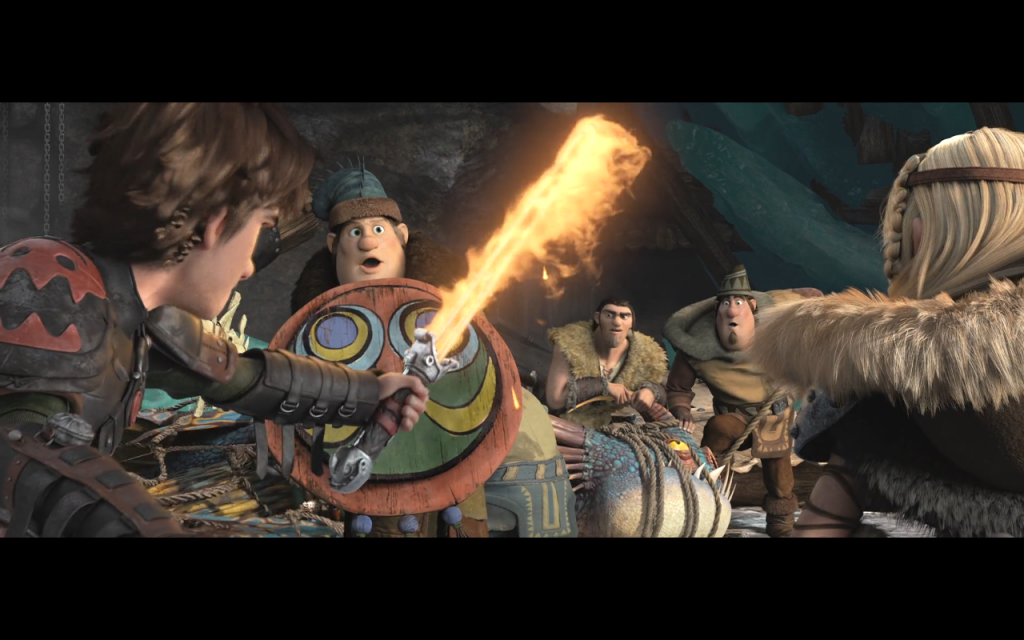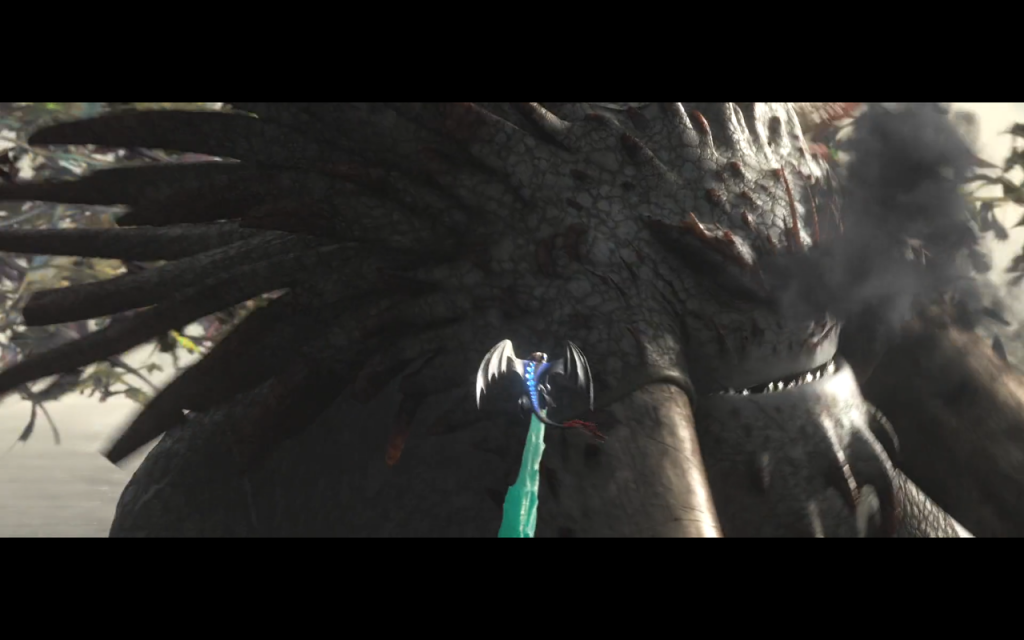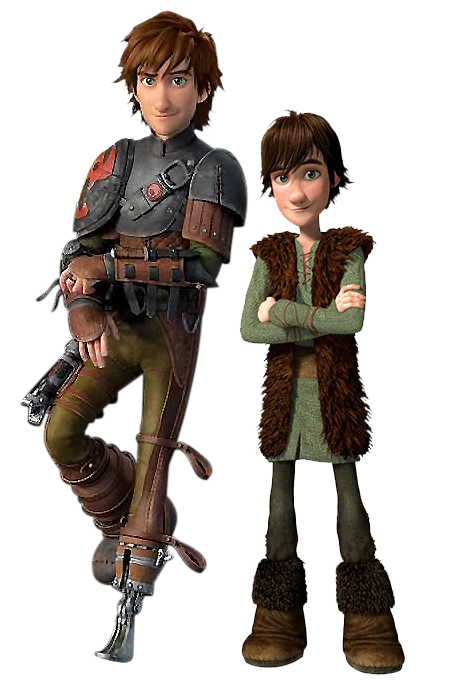Five years after Hiccup successfully ended the war between humans and dragons, he faces many new conflicts. He and his village of both species are living happily until they learn that the cruel and brutal Drago Bludvist is building a dragon army and will soon come to take them over. While rushing out to stop him, Hiccup also faces the fact that he has come of age. His chief father will soon ask him to put aside his wayward exploring and learn how to become the next leader of Berk, but he does not believe he can shoulder the duty well. If these challenges were not enough, Hiccup also finds his long-lost mother—who adores dragons just as much as he does—and works to recreate a relationship with her, even as the threat of Drago looms over them.
Like its prequel, this film follows a classic adventure structure—the hero learns of a great evil and sets out to stop it. This plot is carried by the film’s CGI animation. It allows Hiccup’s world to continue offering exciting, colourful dragons and their convincing movements, from swooping flights to facial expressions. The series also becomes more action-based with more theatrical escapes, and battles with dragons on different sides ramming into each other like stags as just a few examples. A French promotional poster. The tagline translates to: “This summer, take flight!” While action-adventure offers much of the film’s entertainment, it stays family-oriented. Hiccup gains a brand-new relationship in his mother—who has her own character arc of readjusting to her human family—and he matures from being a detached young adult to embracing his role as chief. Also dragons are still plot-central, but the main antagonist is no longer one. This is for the best, as early film narratives featuring animals have been questioned: ‘Was there any reason […] why they should not also have heroes, or for that matter villains? There was one: none of these things are found in nature.’ (Bousé, Wildlife Films, p. 129.) Since this film has a human antagonist with the human desire for tyrannical power, the unnaturalness of this hero-villain divide among animals has become less of an issue. The end of the antagonism between humans and dragons in the last film means that dragons are now fully integrated into the human village. In the film’s opening sequence, Hiccup explains through voiceover how the people have accommodated the dragon population with ‘custom stables’ and ‘all-you-can-eat feeding stations’ among other things. The sequence also shows the village youths racing dragons for sport, and these things demonstrate that humans and dragons have successfully embraced each other. It is clear that there is no more conflict over food now that the parasitic Green Death villain is dead, and both species, humans and dragons, appear to be thriving thanks to each other. The village is idyllic but still enclosed, which brings attention to Hiccup’s wanderings. For him in particular, having a dragon opens up the world and gives him the opportunity to follow his desire of going out and charting unknown territory. Beyond this, his dragon Toothless is his constant companion and the subject of study for Hiccup’s inventions, such as his gliding suit and his multi-purpose tool which can be used to tame dragons—notably he has designed it to do so through non-contact peaceful means. This develops his character as a forward-thinking peacemaker. Essentially, dragons enrich the lives of all Berk’s people, and Toothless serves to characterise Hiccup.

Hiccup demonstrates his dragon-inspired technology for self-defence Berk works because dragons are conceptualised as unfailingly loyal and submissive to their humans. There are countless examples of Toothless shielding Hiccup’s body with his own, or holding back against hostiles because Hiccup instructs him to. Furthermore dragons are made highly intelligent. Hiccup’s mother, Valka, states her dragon is no ‘vicious beast, but an intelligent, gentle creature, whose soul reflected [her] own’. In practise, during the first skirmish between Hiccup’s posse and Eret’s dragon trappers, Toothless shoots a fireball to dislodge ice above some enemy men, incapacitating them, showing sophisticated fighting tactics. Dragons are emotionally intelligent too, keenly understanding and observing human feelings and wishes. For example when Ruffnut is offended at Snotlout’s flirting, her dragon mirrors her facial expression of offence and flies her away from him without prompt, demonstrating immense care for the subtleties in human emotion. Also, not once in the film does an owned dragon ever disregard their human’s wishes—many, including Toothless, defect from the side of the hero to the villain because of biological compulsion (an ability of the alpha kind). However this is never because a dragon personally wants to disobey a human—desire like that does not exist in this film. Instead it is due to a conflict between their master humans. This degree of loyalty is the most fantastical feature of the film, as no real-world animal is capable of it.

Toothless attacks a behemoth for Hiccup When it comes to the original hierarchy of dragons, ‘[t]he right over […] animals is acquired in the same way as over the persons of men, that is, by natural strength and powers.’ (Derrida, The Beast and the Sovereign, p. 30.) Although it is mostly used in the plot as a straightforward source of conflict, the alpha species ability of natural biological compulsion has far-reaching implications for the power structures of dragonkind. After Drago uses his alpha to make Toothless kill Stoic, a distraught Hiccup lashes out at his dragon. Valka attempts to appease Hiccup and his understandable but unfair feelings of betrayal by stating ‘good dragons under the control of bad people do bad things’. In this, Valka and the film at large argue that what appears to be “natural” (the alpha ability, which is actually being exploited by the human Drago) is not necessarily desirable to humans or animals, and if not desirable, it should be resisted. Dragons are made to have individuality just as people do—it is Toothless specifically who loves and shares his life with Hiccup; he and all the other dragons are not interchangeable or replaceable. This individuality can be attacked at its core to the point where a loving dragon is made capable of killing his best friend’s father, and this is horrifying to humans on a primal level: we despise the idea of losing our autonomy and through empathy can believe a rational animal’s loss of autonomy is just as bad. In order to have a happy ending, the film must show that this ugly force of compulsion can be defeated, even if it seems justified by “nature”. Once the strength of the bond between Toothless and Hiccup proves victorious over the alpha dragon and Drago, all the other dragons, and the humans too, are free to determine for themselves that Toothless and Hiccup are the best leaders for them. Considering other freedoms, while the freedom of flight is taken for granted by dragons, for Hiccup and his fellow humans, the ability to explore the sky on their dragons is an incredible privilege. Also the narrative makes it so that Hiccup and Toothless’ exploring is vital to the safety of Berk. In no other way could Hiccup have learned of Drago and the growing threat he poses, and the main characters would have been unprepared to resist him. Hiccup also could not have connected with his lost mother. Overall the narrative makes the dragons represent and enable human freedom, sustenance, safety and familial relationships. Real life domesticated animals also represent these things, so the film is a celebration of animal domestication. This is a narrow position for the film’s animals. Toothless is definitely an individual character as far as the audience’s emotional investment in him is concerned. However only Hiccup and the other humans experience any character change. It is Hiccup who loses his father and learns from his mother what he must be in order to mature: ‘You have the heart of a chief and the soul of a dragon. Only you can bring our worlds together. That is who you are, son.’ Hiccup earns his place as chief through his just and determined leadership, which sets him apart from Drago. Toothless however seems to become the alpha dragon inevitably, because he does at the film’s climax what he has been doing the entire film—protecting Hiccup—but simply on a larger scale. He acts as an enhancing tool to Hiccup’s character arc, because as the protagonist and therefore the most important character, Hiccup must have the most striking and important dragon.

Comparison of Hiccup’s character models On a broad scale, since dragons are characterised as inherently submissive, the film creates a rigid power structure in the animal world—every dragon nest must have an alpha. This is contradicted by the film’s opening, when the dragons of Berk are shown functioning fine without one. This power vacuum is “fixed” by the film’s end when Toothless takes the role. Thematically, he must do so in order to match Hiccup, and the power structure of the dragons becomes problematic here. It is supposed to serve as a parallel to the human social order, where Hiccup is chief, making it appear that a human autocracy is natural too, and therefore the correct way. However this is a naturalistic fallacy, which the film recognises when it uses Drago to show how autocracy can be corrupt. This confuses the way Berk is structured by the film’s end. The justification that Hiccup and Toothless seem to have in being leaders by the end is that they do not happen to exploit the already-established loyalty of their subjects. This may work for their specific situation but is not the most helpful model of social order to present to the audience, because this example relies on part of the order, the dragons, being absolutely happily submissive. This cannot be guaranteed for any real world group, human or animal. More narrowly, Hiccup says at the film’s climax, ‘Once you’ve earned his loyalty, there is nothing a dragon won’t do for you.’ The film uses dragons to explore the dual connection between an owner and a pet. On one hand, the owner role that Hiccup acts in is a parental figure to their pet, having the authority to control them along with the duty to care for them. On the other, the pet Toothless is willing and able to protect their owner from physical threats as if the owner was the pet’s offspring. This two-way familial relationship is very emotionally enticing, and by portraying it, the film essentially teaches the audience that such a relationship with an intelligent animal is a positive and desirable thing. Here the dragons offer unconditional love and support, and their relationships with the people of Berk are built on respect, not tyranny as Drago is defined by. The film presents animals as intelligent, emotive and wilful just like humans, which pushes the audience to empathise with them. The implication that they value concepts like family and liberty in the same way humans do are seen as more truthful because of this. The unwavering loyalty and familial love of the dragons calls back to dogs like the titular character in Lassie Come Home and the television series it was based on—just like Toothless, Lassie is willing to go above and beyond for the sake of their owner. The cat and two dogs of Homeward Bound: The Incredible Journey are further examples, being willing to travel countless miles to be reunited with the human children that the pets are convinced need their care. These animal characters have in common great understanding of and responsiveness to the smallest commands, requests or even mildly expressed needs of their humans. They also ignore personal threat to protect or defend their loved ones, a popular fantasy of unconditional love among audiences. Also, like in the prequel, the dragons are an amalgamation of many other animal species: cats with their slinking ground movements and cuteness, lizards with their eyes, skin and heat retention, birds of prey with their hunting methods, and bees with their social structure. The lasting appeal of these dragons is thanks to their designers taking the most interesting and appreciated traits of many species and rolling them into one.
Further Reading
- ‘How to Train Your Dragon 2 Deleted Scene – Alternate Opening (2014) – Dreamworks Movie HD‘
- ‘Kit Harington on How to Train Your Dragon 2: “Where’s your father? Where are all the parents in this scenario?”‘
- Richard Corliss, ‘How to Train Your Dragon 2 at Cannes: Beasts of the Viking Wild‘
- ‘The Technology Behind How to Train Your Dragon 2‘
Bibliography
- Bousé, Derek, ‘The Classic Model’, in Wildlife Films (Philadelphia: University of Pennsylvania Press, 2000), pp. 127-51
- Derrida, Jacques, ‘First Session: December 12, 2001’, in The Beast and the Sovereign, Vol. 1, trans. by Geoffrey Bennington (Chicago:, University of Chicago Press, 2009), pp. 1-31
- Homeward Bound: The Incredible Journey. Dir. Duwayne Dunham. Buena Vista Pictures. 1993
- How to Train Your Dragon. Dir. Dean DeBlois & Chris Sanders. Paramount Pictures. 2010
- Lassie Come Home. Dir. Fred M. Wilcox. Metro-Goldwyn-Mayer. 1943